Abstract
The surface immunoglobulin of the transplantable L2C leukaemia of strain 2 guinea-pigs has been investigated. The immunoglobulin is seen to be synthesized when the cells are maintained in culture, indicating its intrinsic origin. Immunolabelling of the cell surface and immunochemical study of the Fab released by limited surface proteolysis indicate the presence of immunoglobulin of class IgM. IgG and free light chains were not detected, and there is unlikely to be an appreciable amount of immunoglobulin of any other class. The amount of immunoglobulin present, in terms of 4-chain monomers, is approximately 100,000 molecules per cell. Its half-life, calculated from the rate of reappearance in vitro of surface Fab after proteolytic clearing, is approximately 5 hours. Immunoglobulin secreted into the environment appears to arise predominantly or entirely from the cell surface: there is no evidence of an appreciable export of immunoglobulin which does not have a surface phase. Papain at 0.06 mg/ml rapidly removes the surface Fab. Residual Fcmu can then be detected by immunofluorescence, suggesting that papain cleaves surface IgM at a hinge region with the molecule in situ on the membrane. The released Fab is only moderately susceptible to degradation by papain at the enzyme: substrate ratio prevailing. It has been possible to isolate it from the papain digest by immuno-adsorption, with a notional yield of 75 mug per 10-10 cells, and then to prepare antisera against it.
Full text
PDF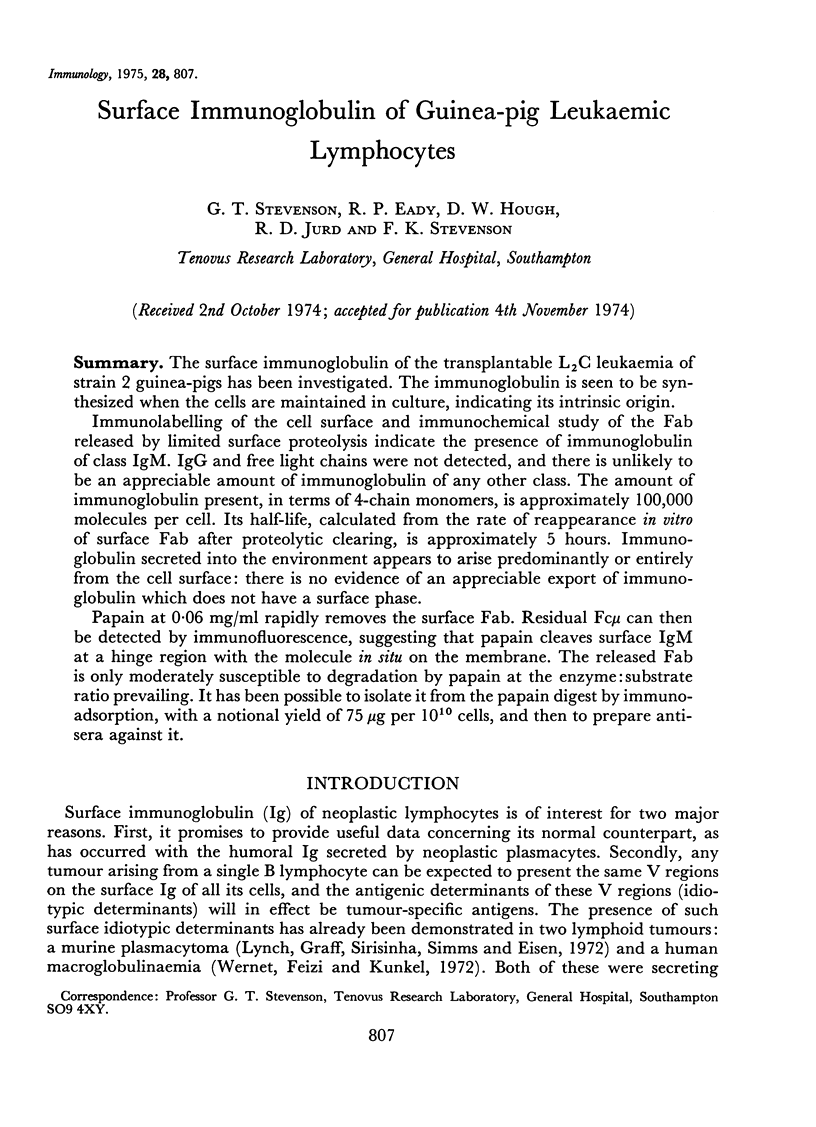
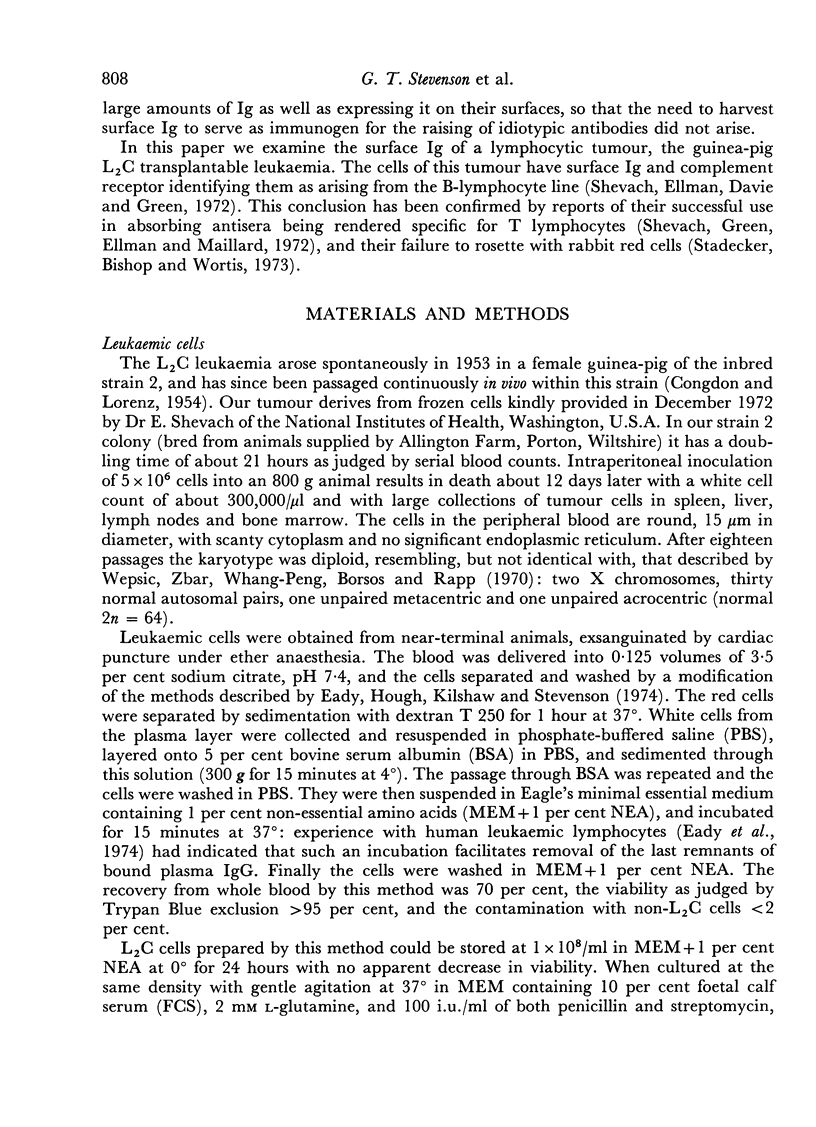


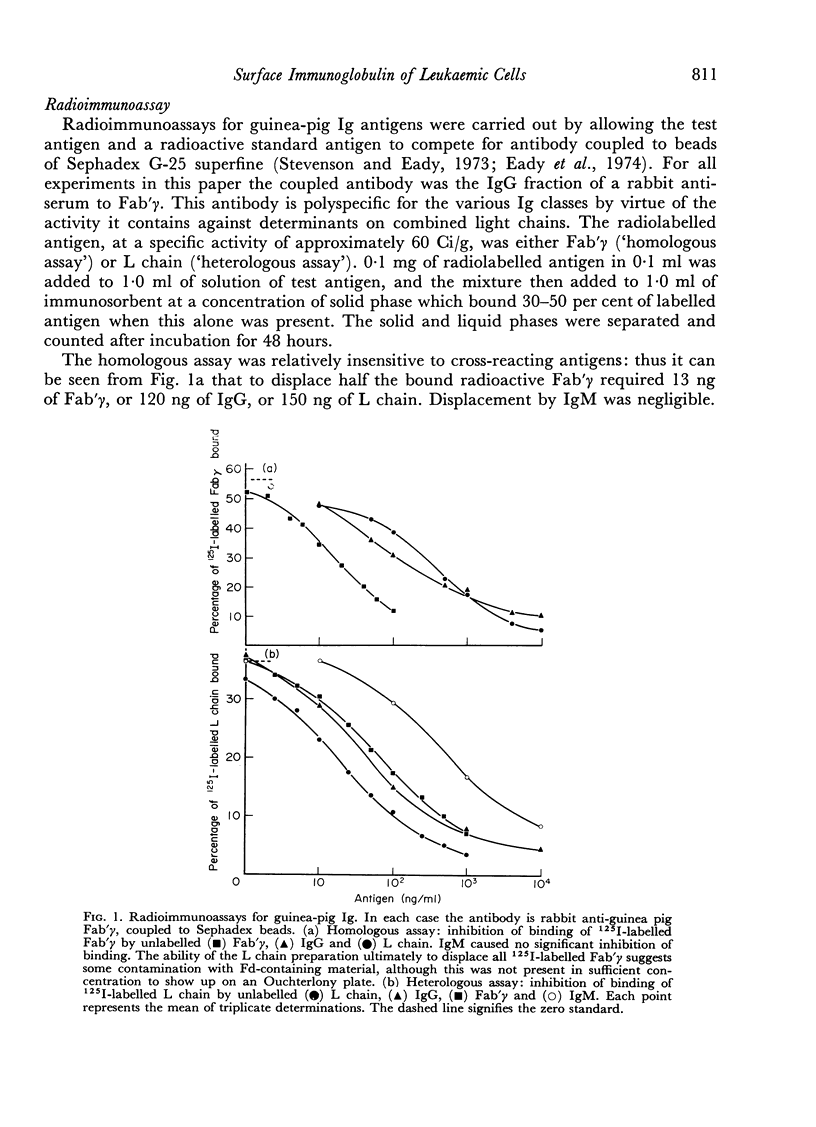



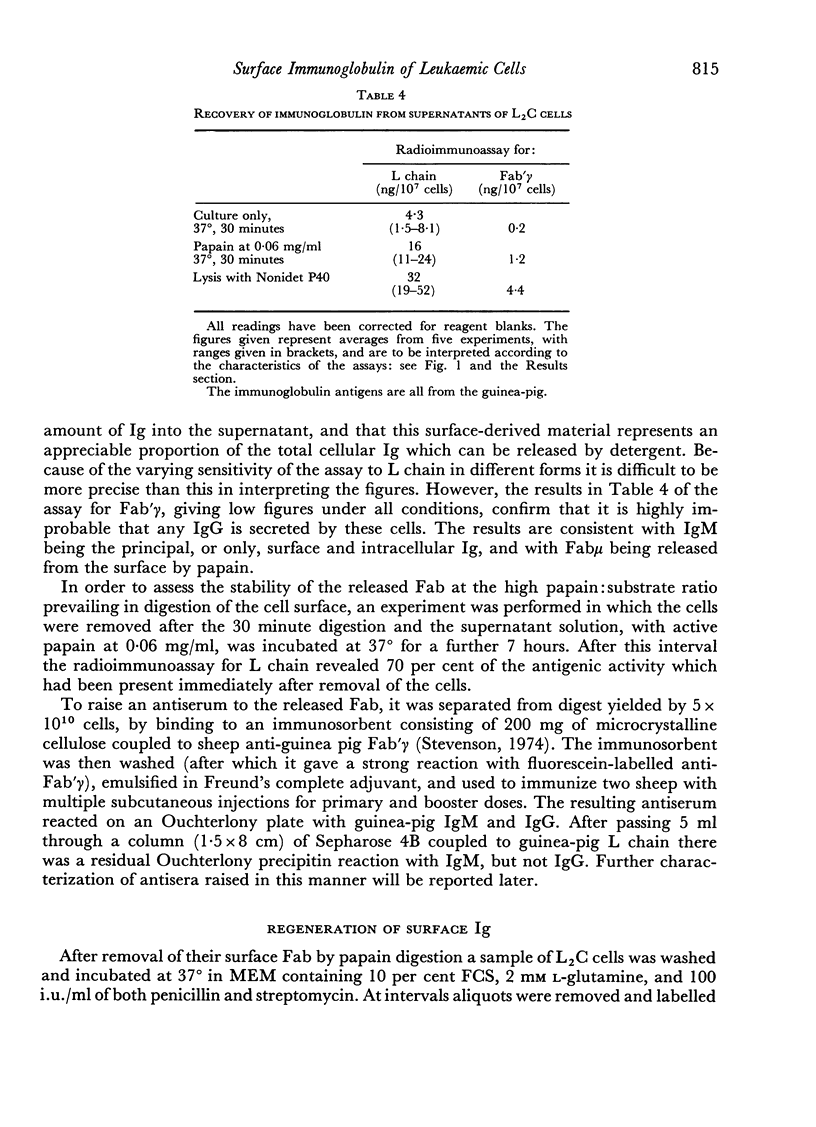

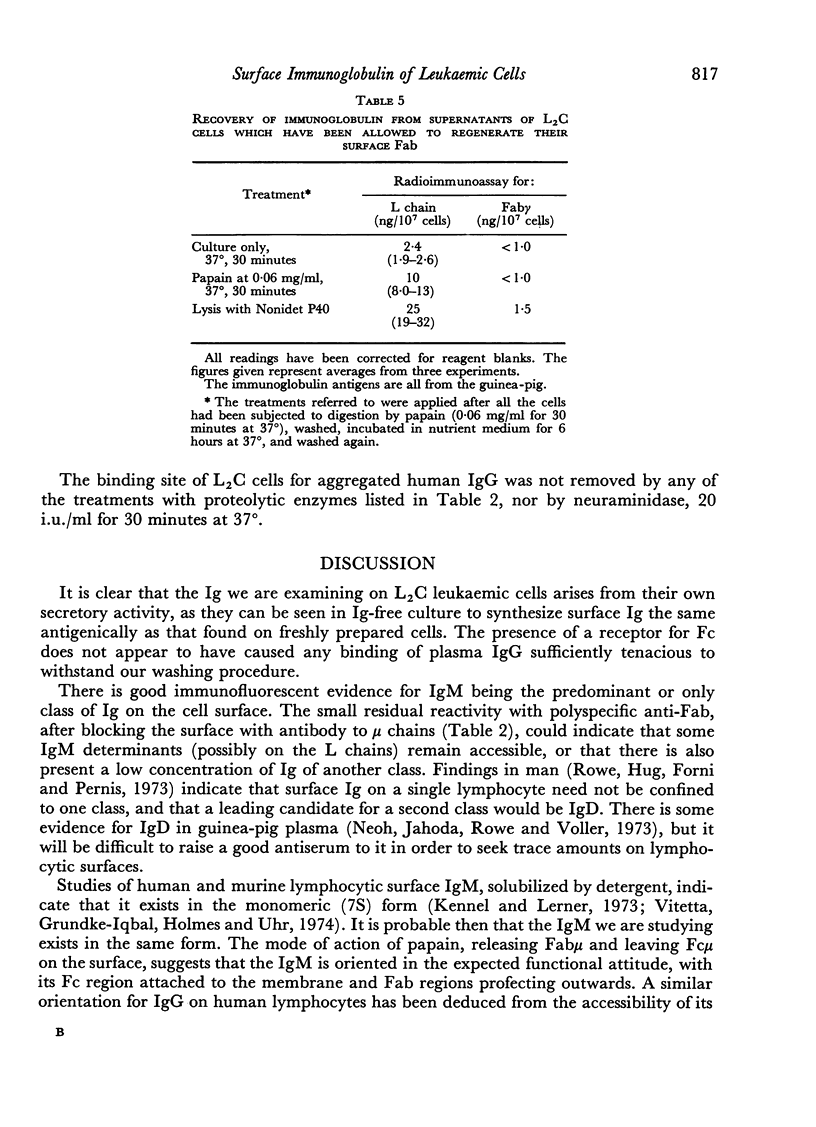

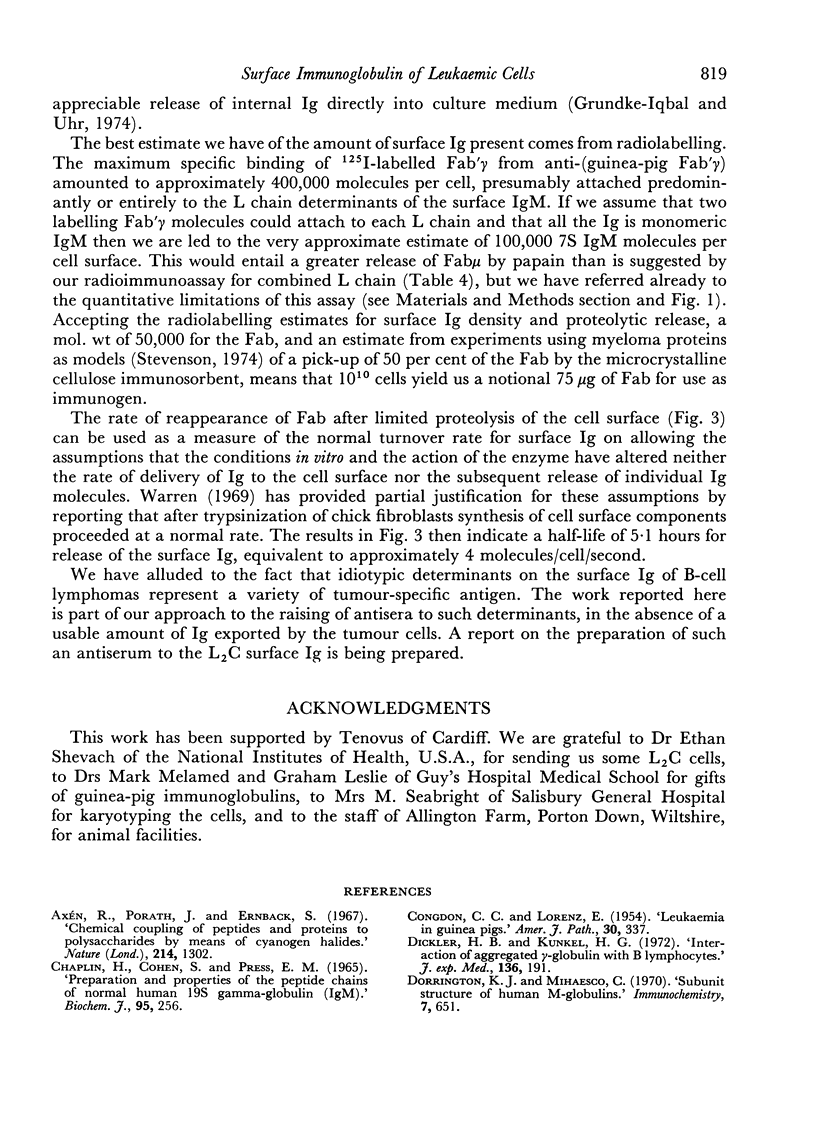
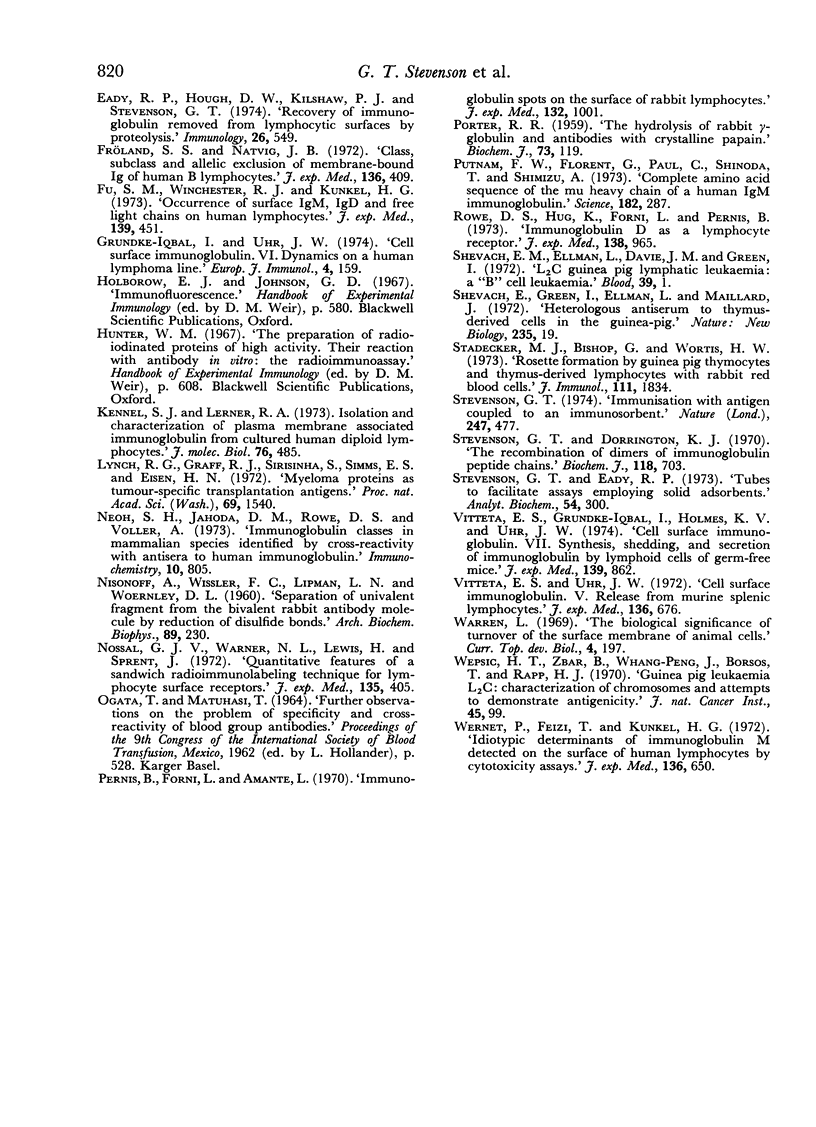
Selected References
These references are in PubMed. This may not be the complete list of references from this article.
- Axén R., Porath J., Ernback S. Chemical coupling of peptides and proteins to polysaccharides by means of cyanogen halides. Nature. 1967 Jun 24;214(5095):1302–1304. doi: 10.1038/2141302a0. [DOI] [PubMed] [Google Scholar]
- CHAPLIN H., COHEN S., PRESS E. M. PREPARATION AND PROPERTIES OF THE PEPTIDE CHAINS OF NORMAL HUMAN 19 S GAMMA-GLOBULIN (IGM). Biochem J. 1965 Apr;95:256–261. doi: 10.1042/bj0950256. [DOI] [PMC free article] [PubMed] [Google Scholar]
- CONGDON C. C., LORENZ E. Leukemia in guinea-pigs. Am J Pathol. 1954 Mar-Apr;30(2):337–359. [PMC free article] [PubMed] [Google Scholar]
- Dickler H. B., Kunkel H. G. Interaction of aggregated -globulin with B lymphocytes. J Exp Med. 1972 Jul 1;136(1):191–196. doi: 10.1084/jem.136.1.191. [DOI] [PMC free article] [PubMed] [Google Scholar]
- Dorrington K. J., Mihaesco C. Subunit structure o human gamma-M-globulins. Immunochemistry. 1970 Jul;7(7):651–660. doi: 10.1016/0019-2791(70)90247-8. [DOI] [PubMed] [Google Scholar]
- Eady R. P., Hough D. W., Kilshaw P. J., Stevenson G. T. Recovery of immunoglobulin removed from lymphocytic surfaces by proteolysis. Immunology. 1974 Mar;26(3):549–561. [PMC free article] [PubMed] [Google Scholar]
- Fröland S. S., Natvig J. B. Class, subclass, and allelic exclusion of membrane-bound Ig of human B lymphocytes. J Exp Med. 1972 Aug 1;136(2):409–414. doi: 10.1084/jem.136.2.409. [DOI] [PMC free article] [PubMed] [Google Scholar]
- Fu S. M., Winchester R. J., Kunkel H. G. Occurrence of surface IgM, IgD, and free light chains of human lymphocytes. J Exp Med. 1974 Feb 1;139(2):451–456. doi: 10.1084/jem.139.2.451. [DOI] [PMC free article] [PubMed] [Google Scholar]
- Grundke-Iqbal I., Uhr J. W. Cell surface immunoglobulin. VI. Dynamics on a human lymphoma line. Eur J Immunol. 1974 Mar;4(3):159–163. doi: 10.1002/eji.1830040303. [DOI] [PubMed] [Google Scholar]
- Kennel S. J., Lerner R. A. Isolation and characterization of plasma membrane associated immunoglobulin from cultured human diploid lymphocytes. J Mol Biol. 1973 Jun 5;76(4):485–502. doi: 10.1016/0022-2836(73)90487-7. [DOI] [PubMed] [Google Scholar]
- Lynch R. G., Graff R. J., Sirisinha S., Simms E. S., Eisen H. N. Myeloma proteins as tumor-specific transplantation antigens. Proc Natl Acad Sci U S A. 1972 Jun;69(6):1540–1544. doi: 10.1073/pnas.69.6.1540. [DOI] [PMC free article] [PubMed] [Google Scholar]
- NISONOFF A., WISSLER F. C., LIPMAN L. N., WOERNLEY D. L. Separation of univalent fragments from the bivalent rabbit antibody molecule by reduction of disulfide bonds. Arch Biochem Biophys. 1960 Aug;89:230–244. doi: 10.1016/0003-9861(60)90049-7. [DOI] [PubMed] [Google Scholar]
- Neoh S. H., Jahoda D. M., Rowe D. S., Voller A. Immunoglobulin classes in mammalian species identifed by cross-reactivity with antisera to human immunoglobulin. Immunochemistry. 1973 Dec;10(12):805–813. doi: 10.1016/0019-2791(73)90184-5. [DOI] [PubMed] [Google Scholar]
- Nossal G. J., Warner N. L., Lewis H., Sprent J. Quantitative features of a sandwich radioimmunolabeling technique for lymphocyte surface receptors. J Exp Med. 1972 Feb 1;135(2):405–428. doi: 10.1084/jem.135.2.405. [DOI] [PMC free article] [PubMed] [Google Scholar]
- PORTER R. R. The hydrolysis of rabbit y-globulin and antibodies with crystalline papain. Biochem J. 1959 Sep;73:119–126. doi: 10.1042/bj0730119. [DOI] [PMC free article] [PubMed] [Google Scholar]
- Pernis B., Forni L., Amante L. Immunoglobulin spots on the surface of rabbit lymphocytes. J Exp Med. 1970 Nov;132(5):1001–1018. doi: 10.1084/jem.132.5.1001. [DOI] [PMC free article] [PubMed] [Google Scholar]
- Putnam F. W., Florent G., Paul C., Shinoda T., Shimizu A. Complete amino acid sequence of the Mu heavy chain of a human IgM immunoglobulin. Science. 1973 Oct 19;182(4109):287–291. doi: 10.1126/science.182.4109.287. [DOI] [PubMed] [Google Scholar]
- Rowe D. S., Hug K., Forni L., Pernis B. Immunoglobulin D as a lymphocyte receptor. J Exp Med. 1973 Oct 1;138(4):965–972. doi: 10.1084/jem.138.4.965. [DOI] [PMC free article] [PubMed] [Google Scholar]
- Shevach E. M., Ellman L., Davie J. M., Green I. L2C Guinea pig lymphatic leukemia: a "B" cell leukemia. Blood. 1972 Jan;39(1):1–12. [PubMed] [Google Scholar]
- Stadecker M. J., Bishop G., Wortis H. H. Rosette formation by guinea pig thymocytes and thymus derived lymphocytes with rabbit red blood cells. J Immunol. 1973 Dec;111(6):1834–1837. [PubMed] [Google Scholar]
- Stevenson G. T., Dorrington K. J. The recombination of dimers of immunoglobulin peptide chains. Biochem J. 1970 Aug;118(5):703–712. doi: 10.1042/bj1180703. [DOI] [PMC free article] [PubMed] [Google Scholar]
- Stevenson G. T., Eady R. P. Tubes to facilitate assays employing solid adsorbents. Anal Biochem. 1973 Jul;54(1):300–303. doi: 10.1016/0003-2697(73)90279-0. [DOI] [PubMed] [Google Scholar]
- Stevenson G. T. Immunisation with antigen coupled to an immunosorbent. Nature. 1974 Feb 15;247(5441):477–478. doi: 10.1038/247477a0. [DOI] [PubMed] [Google Scholar]
- Vitetta E. S., Grundke-Iqbal I., Holmes K. V., Uhr J. W. Cell surface immunoglobulin. VII. Synthesis, shedding, and secretion of immunoglobulin by lymphoid cells of germ-free mice. J Exp Med. 1974 Apr 1;139(4):862–876. doi: 10.1084/jem.139.4.862. [DOI] [PMC free article] [PubMed] [Google Scholar]
- Vitetta E. S., Uhr J. W. Cell surface immunoglobulin. V. Release from murine splenic lymphocytes. J Exp Med. 1972 Oct 1;136(4):676–696. doi: 10.1084/jem.136.4.676. [DOI] [PMC free article] [PubMed] [Google Scholar]
- Warren L. The biological significance of turnover of the surface membrane of animal cells. Curr Top Dev Biol. 1969;4:197–222. doi: 10.1016/s0070-2153(08)60485-8. [DOI] [PubMed] [Google Scholar]
- Wepsic H. T., Zbar B., Whang-Peng J., Borsos T., Rapp H. J. Guinea pig leukemia L2C: characterization of chromosomes and attempts to demonstrate antigenicity. J Natl Cancer Inst. 1970 Jul;45(1):99–105. [PubMed] [Google Scholar]
- Wernet P., Feizi T., Kunkel H. G. Idiotypic determinants of immunoglobulin M detected on the surface of human lymphocytes by cytotoxicity assays. J Exp Med. 1972 Sep 1;136(3):650–655. doi: 10.1084/jem.136.3.650. [DOI] [PMC free article] [PubMed] [Google Scholar]


